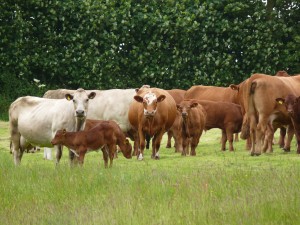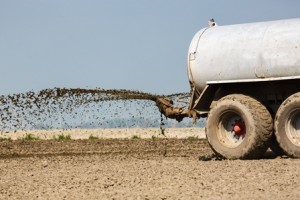Cattle Diseases
Campylobacteriosis in Cattle
Campylobacteriosis is an infection by the bacteria Campylobacter spp., and is associated with a number of disease conditions in cattle, primarily related to poor fertility in breeding cows and diarrhea in young stock. Campylobacteria are also potentially a zoonotic pathogen which can cause diarrhea in humans and is therefore of importance in food production.
Campylobacter and Infertility in Cattle
Campylobacter fetus subspecies venerealis and Campylobacter fetus subspecies fetus are most commonly associated with early embryonic death and abortion (Bondurant, 2005; Campero et al., 2005) . Campylobacter jejuni is seldom reported as a primary cause of abortion in cattle in the UK. It has been suggested that Campylobacteria may be a significant cause of infertility in suckler herds through spread as venereal disease and should be considered if poor fertility is reported in a suckler (or natural service dairy) herd (Caldow and Taylor, 1997). The most important sign of disease is a high incidence of returns to service with prolonged interoestrus intervals.
Enteritis – Calf Scours
Enteritis (calf scour) due to primary Campylobacteria infection is not thought to be a common cause of scouring in calves (Scott et al., 2004). However, Campylobacteria may be found on fecal sample examination in combination with other pathogens or may be a secondary pathogen resulting from opportunistic infection following previous gut damage.
Campylobacteriosis is a Zoonotic Disease
Campylobacterial infection of people causes diarrhea and can be severe in some cases. Zoonotic disease is thought to be due mainly to contamination of meat and meat products at the abattoir (Small et al., 2002, 2003), during meat processing and storage, but best management practices on-farm are advisable to reduce the potential carriage in livestock (Bicudo and Goyal, 2003).
Epidemiology of Campylobacter Infection
Campylobacter are carried asymptomatically in the preputial area of bulls (Taylor, 2002). After infection of a cow at service early embryonic death or abortion can be followed by a short duration of immunity.

Campylobacter can be found in bovine manures and slurry, and has been detected on pasture after slurry spreading for up to 64 days (Hutchison et al., 2005b).
Campylobacter spp. in bovine feces have been reported at the same prevalence on organic and conventional dairy farms, with no difference in antimicrobial sensitivity patterns (Sato et al., 2004). Estimates of prevalence of Campylobacteria presence in feces from different farms varies between 25-75% of farms (Grinberg et al., 2005; Sato et al., 2004). However, campylobacter prevalence is higher in calf feces compared to adult cows and there may be an increase in shedding in spring in adult animals (Sato et al., 2004; Stanley and Jones, 2003). Approximately one third of calves have been found to excrete Campylobacteria in feces compared to around 5% of adult beef cows (Grinberg et al., 2005) . An increased prevalence of Campylobacter isolation in cattle feces has been associated with an increased rate of abortion (Sato et al., 2004). Due to fecal carriage, Campylobacteria can be found in manure and slurry (Stanley and Jones, 2003) especially if calves under three months old or piglets are contributing to the manure (Hutchison et al., 2005a). Campylobacteria can be detected on pasture after slurry spreading for up to 64 days (Hutchison et al., 2005b) and has also been detected in raw bulk tank milk (Jayarao and Henning, 2001) and in water troughs and water courses (Kemp et al., 2005). Campylobacter from fecal contamination of carcasses have been detected at slaughter, which may be a potential source of zoonotic spread (al-Saigh et al., 2004).
Control and Prevention of Campylobacteriosis
When using a bull for natural service, the possibility of venereal disease should be considered especially when purchasing mature bulls. Individual bulls that have been used on herds of unknown disease status can be prophylactically treated by repeated antimicrobial preputial washings. However, it is advisable to use artificial insemination (AI) to prevent venereal spread of Campylobacteria or to only buy in bulls that have not worked on other herds. The prevention of disease spread in the herd should be addressed in the Herd Health Plan.
Control of spread of Campylobacteria from bovine feces via manure or slurry spreading or fecal contamination of carcasses at the abattoir are more difficult. Campylobacter are thought to reduce significantly in slurry storage within 64 days (Hutchison et al., 2005b). However, their survival following slurry spreading is less well known. Good practice of composting should ensure that Campylobacter (and other potential zoonotic pathogens such as Salmonella and E. coli) should be reduced within 5 days due to the high temperatures reached (>50˚C) (Hutchison et al., 2005c).
Treating Campylobacteriosis
Bulls carrying Campylobacteria can be treated by repeated antimicrobial preputial washes and may require additional injectable antibiotics (Revell, 1998; Taylor, 2002). Calves with diarrhea should be treated as appropriate; see section on calf scour.
Good Practice Based on Current Knowledge
If a herd has a diagnosed Campylobacter infertility problem, AI should be used to control spread of disease. Control of infertility due to Campylobacteria should be based on prevention. Therefore the following are recommended:
Fertility
- New bulls should be sourced carefully – ideally they should not have worked on a farm of unknown disease status
- Testing bulls for carriage of Campylobacteria can be undertaken by taking a preputial sheath wash (Taylor, 2002)
- Antimicrobial preputial washing by the farm’s veterinary surgeon may be considered of bulls with an unknown health status
Environmental Pathogen Reduction
- Compost animal waste materials thoroghly
- Try to avoid continuously topping-up slurry tanks if possible, to allow reduction in pathogen content in batches
- Leave grazing for at the very minimum 3 weeks after application of slurry or dirty water to allow reduction in pathogen load before allowing animals on to graze
- Treat and isolate calves promptly that have diarrhea and ensure that people handling scouring calves practice basic hygiene principles (i.e. washing hands)


 British English
British English



Comments are closed.